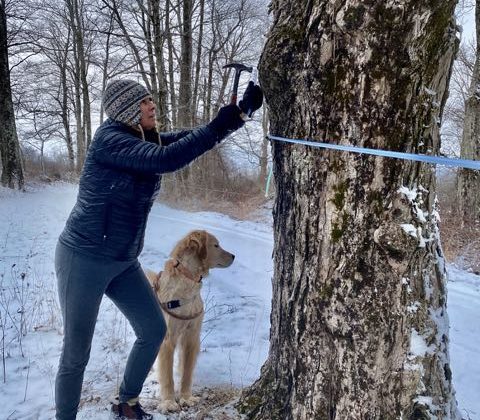Maple Syrup Makers Experience Unusually Early Sap Season
Text by Jude Mead
Photo by Winter Mead
The Farmer’s Almanac, a periodical that has provided long-range weather predictions since 1818, was right again. It predicted above normal temperatures in our area this winter, and most maple syrup producers agree that it was spot on. Many producers took advantage of the warm weather. I was one of them. With a drill in hand and an apron full of spouts, my husband and I headed into the sugar bush to tap the trees. This is only the second time in over 30 years we were prepared for what we call “very early runs.”
Maple syrup production is weather dependent. For the sap to run we need warm days usually a bit above 40 degrees and below-freezing nights averaging around 28 degrees. There were enough of those days in January and February to fire up the evaporator. We were not the only ones prepared. According to Peter Gregg, the publisher of The Maple News, many producers were ready. “Producers who tapped their trees especially during the January thaw made syrup, although not huge amounts,” said Gregg.
Jessica Holmes, a horticulture educator who works with the Cornell University Cooperative Extension Center, agreed with Gregg. “With so many warm days and cold nights, the weather was exceptional for making maple syrup,” said Holmes. She thought this might be the earliest date sugarmakers have ever boiled but was not certain. According to both Gregg and Holmes, the season usually gets rolling in earnest about mid-February.
This hasn’t always been the norm. When we first began making maple syrup the sap did not run until March. Then we would boil every day for almost three weeks straight. Come the first of April the nights usually stayed above 32 degrees, the days shot up to 50 degrees, and the buds rolled out on the trees. The season ended. Today the pattern has changed, and the season begins sooner.
Tapping the trees early, however, has its disadvantages. Because the warm days and cool nights are sporadic, the producer takes the risk of having the taps close if a long cold snap comes. This means all those hours of drilling the holes has to be repeated. This is backbreaking work and time consuming.
Making maple syrup is a process. Two methods used to tap the tree are the traditional bucket and spout method and the tubing method. The bucket and spout method is simply drilling a small hole into the tree and tapping in the spout. A bucket with a cover is then hooked into place. The tubing method is a bit more complicated. It involves the same drilling and spout insertion, but with this method a web of tubing lines connect from tree to tree and flow into a thicker line that carries the sap to a holding tank or flows directly to the sugar house.
Once the sap is gathered, it is then boiled in a stainless steel evaporator that is fueled by wood or oil. When the temperature of the sap reaches 7 degrees above the boiling point of water for the day (usually 212 degrees), the syrup is drawn off into containers. To ensure proper density for syrup, the combination of a thermometer and hydrometer are most often used. Syrup is then filtered through a press, color-graded and packaged. It takes 40 gallons of sap to make one gallon of syrup.
Maple syrup is graded from light to dark. The syrup color changes as the sugaring season progresses: lighter syrup is usually made when the sap first begins to flow; darker syrup shows up later. The grades include Grade A golden, amber rich, dark robust, and dark strong.
It is a person’s individual taste, though, that decides the “best” grade. According to Holmes, people love the taste of syrup, but they are also enjoying other products made from maple. “Some of the best-selling products are maple candy, maple sugar, maple cotton candy, maple tea, maple butter, maple cream, maple taffy and even maple-flavored alcoholic beverages. The list continues to grow,” said Holmes.
The latest trend Holmes sees becoming popular is maple water. “It is just filtered sap. You can buy it online or in stores. There is a lot of nutritional value in it,” said Holmes. She is right. Maple syrup contains zinc, manganese, calcium, potassium, riboflavin and even iron. It is becoming a champion sweetener.
That is why we need to protect this natural resource. We know the season starts earlier and ends sooner, but we must also understand how this affects maple production. The future holds a number of challenges that research may help overcome. “So much research is happening with science and technology to improve the productive range of the sugar maple. Researchers have even conducted studies using maple saplings and vacuum systems to remove sap,” said Holmes. It is also up to maple producers to be good stewards of the land and pay close attention to the health of the maple trees. A strong and productive tree means more delicious maple syrup.

